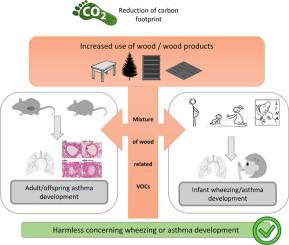Environment International ( IF 10.3 ) Pub Date : 2021-02-18 , DOI: 10.1016/j.envint.2021.106449 Kristin M. Junge , Lisa Buchenauer , Elena Elter , Katja Butter , Tibor Kohajda , Gunda Herberth , Stefan Röder , Michael Borte , Wieland Kiess , Martin von Bergen , Jan C. Simon , Ulrike E. Rolle-Kampczyk , Irina Lehmann , Richard Gminski , Martin Ohlmeyer , Tobias Polte

|
Background
Increased use of renewable resources like sustainably produced wood in construction or for all sorts of long-lived products is considered to contribute to reducing society's carbon footprint. However, as a natural, biological material, wood and wood products emit specific volatile organic compounds (VOCs). Therefore, the evaluation of possible health effects due to wood emissions is of major interest.
Objectives
We investigated the effects of an exposure to multiple wood-related VOCs on asthma development.
Methods
A murine asthma model was used to evaluate possible allergic and inflammatory effects on the lung after short- or long-term and perinatal exposure to pinewood or oriented strand board (OSB). In addition, wood-related VOCs were measured within the German prospective mother–child cohort LINA and their joint effect on early wheezing or asthma development in children until the age of 10 was estimated by Bayesian kernel machine regression (BKMR) stratifying also for family history of atopy (FHA).
Results
Our experimental data show that neither pinewood nor OSB emissions even at high total VOC levels and a long-lasting exposure period induce significant inflammatory or asthma-promoting effects in sensitized or non-sensitized mice. Moreover, an exposure during the vulnerable time window around birth was also without effect. Consistently, in our mother–child cohort LINA, an exposure to multiple wood-related VOCs during pregnancy or the first year of life was not associated with early wheezing or asthma development in children independent from their FHA.
Conclusion
Our findings indicate that emissions from wood and wood products at levels commonly occurring in the living environment do not exert adverse effects concerning wheezing or asthma development.
中文翻译:

木材排放与哮喘的发展:实验性小鼠模型和前瞻性队列研究的结果
背景
人们越来越多地将可再生资源(如可持续生产的木材)用于建筑或用于各种长寿命产品,这被认为有助于减少社会的碳足迹。但是,作为天然的生物材料,木材和木制品会释放出特定的挥发性有机化合物(VOC)。因此,对木材排放可能对健康造成的影响进行评估非常重要。
目标
我们调查了暴露于多种木材相关挥发性有机化合物对哮喘发展的影响。
方法
使用鼠类哮喘模型评估短期或长期和围生期接触松木或定向刨花板(OSB)后可能对肺造成的过敏和炎症作用。此外,在德国前瞻性母婴队列LINA中测量了木材相关的挥发性有机化合物,并通过贝叶斯核仁回归分析(BKMR)估计了它们对儿童早期喘息或哮喘发展的联合影响,直至10岁为止。特应性(FHA)。
结果
我们的实验数据表明,即使在高的总VOC水平和长期的暴露时间下,松木和OSB的排放均不会在致敏或未致敏小鼠中引起明显的炎症或哮喘促进作用。此外,在出生前后的脆弱时间窗口内暴露也没有影响。一致地,在我们的母婴队列LINA中,独立于FHA的儿童在怀孕或生命的第一年暴露于多种与木材相关的VOC与早期喘息或哮喘的发作无关。
结论
我们的发现表明,在生活环境中通常发生的木材和木制品排放不会对喘息或哮喘的发展产生不利影响。











































 京公网安备 11010802027423号
京公网安备 11010802027423号